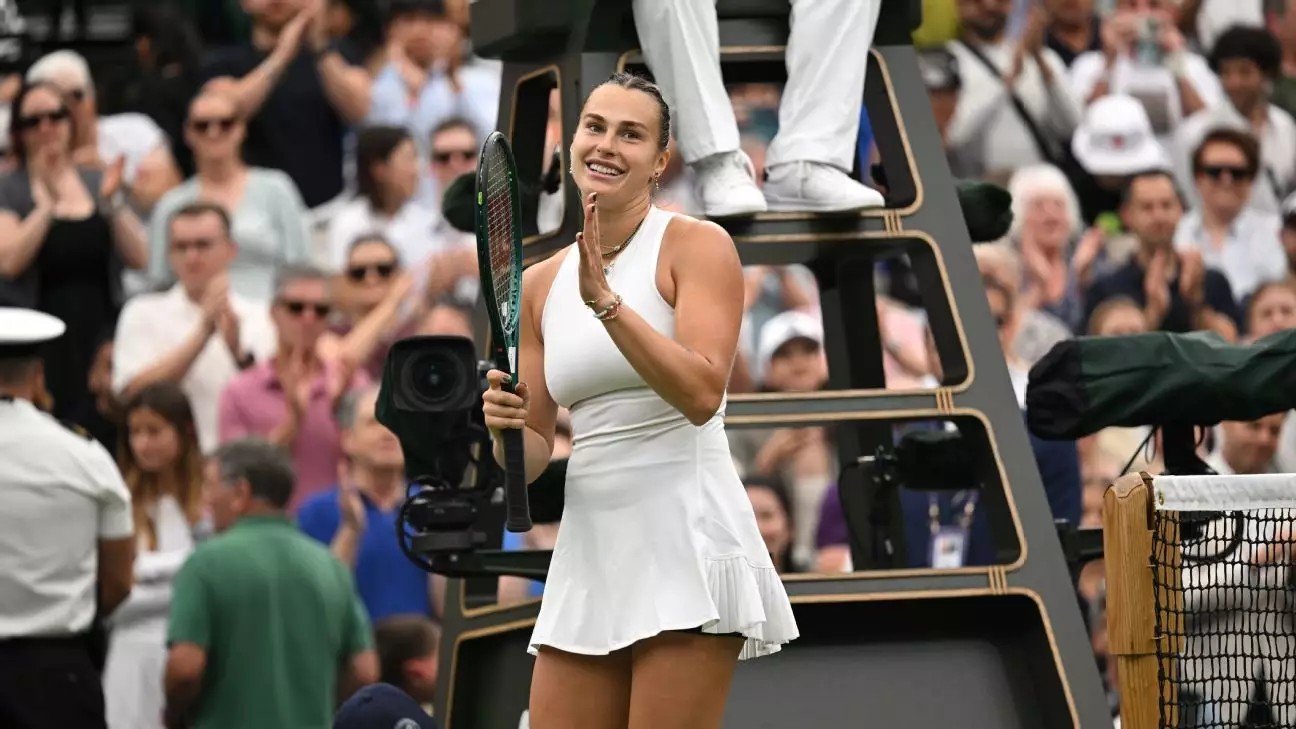Aryna Sabalenka’s latest victory at Wimbledon illuminates not only her extraordinary talent but also her relentless pursuit of excellence in an intensely competitive environment. Her win over Elise Mertens — a 6-4, 7-6 (4) battle — underscores her resilience and mental fortitude. While the scoreline suggests a tight match, it is Sabalenka’s ability to maintain control under pressure that truly sets her apart. Her streak of reaching the quarterfinals in 11 consecutive majors before missing Wimbledon 2024 highlights her consistency; a feat that only Serena Williams has surpassed in the women’s game. This pattern is indicative of a player who thrives amid challenge, continuously elevating her game on tennis’s biggest stage.
Sabalenka’s journey, marked by a robust record against Mertens, reveals that mastery often comes from relentless repetition and adaptation. Despite facing a player with whom she had a dominating 10-2 record, Sabalenka was tested on Centre Court, where her mental resilience shone brightest. Her comeback after losing the early lead showcases her capacity for tactical adjustment and emotional control—traits that are essential for sustained success in Grand Slam tournaments. Her triumph is not just a statement of skill but also of unwavering focus: even when the chips are down, Sabalenka finds a way to push through, especially in high-stakes moments like the tiebreak, where she’s nearly invincible this season.
Challenging Comfort Zones and Embracing Growth
Siegemund’s progression to the quarterfinals at 37, a remarkable milestone, embodies a different form of resilience — one rooted in patience, strategic planning, and a willingness to embrace risk. Her journey to this stage signals that age and experience can become powerful assets rather than barriers. Her recent victories over prominent players and her decisive win against Solana Sierra demonstrate that determination and a calculated approach can defy expectations. In a sport often dominated by youth, Siegemund’s breakthrough reminds us that persistence can unlock new levels of achievement even late in a career.
Siegemund’s statement about adopting a risk-free approach reveals her understanding that survival in this phase of her career depends on smart choices and adaptation. Her acknowledgment of grass as a surface that initially challenged her reflects a broader truth: success often requires players to step outside comfort zones, experiment with new strategies, and redefine their limits. Her decision to participate in warm-up events away from her usual schedule underscores a strategic mindset—one that values gradual growth over complacency. For her, Wimbledon is not just a tournament but a platform for personal evolution, challenging the stereotype that athletic performance diminishes with age.
The Evolving Landscape of Women’s Tennis
The developments at Wimbledon reflect a broader narrative: the sport is evolving from dominant dynasties to a more diverse and unpredictable field. Sabalenka’s rise, alongside Siegemund’s breakthrough, exemplifies how new talent and seasoned veterans are reshaping expectations. Notably, Sabalenka’s skill set—marked by aggressive power and mental toughness—positions her as a dominant force, especially with her impeccable record in tiebreaks. Her assertiveness on court demonstrates a strategic mastery that few can match, highlighting a trend toward players who combine physicality with mental resilience.
Meanwhile, Siegemund’s journey signals that experience, adaptability, and an innovative mindset can forge success even when conventional wisdom suggests otherwise. Her presence in the quarterfinals challenges stereotypes, suggesting that age barriers are increasingly irrelevant in a sport that values strategic intelligence and emotional endurance. As players like Sabalenka and Siegemund push boundaries, women’s tennis is becoming less predictable and more compelling—driven by stories of perseverance, reinvention, and raw determination.
The Power of Connection and Support
Sabalenka’s acknowledgment of the Wimbledon crowd reveals a deeper understanding of the importance of emotional connection in sport. Her gratitude and acknowledgment of the spectators’ support demonstrate that performance is not just about individual prowess but also about forging a symbiotic relationship with fans. Her comment—“With your support, everything is possible”—embodies a recognition that collective energy can uplift athletes to extraordinary heights.
This dynamic presents a compelling narrative: in a sport often defined by individual achievement, the supportive environment—the crowd, the coaches, the fellow players—acts as a catalyst for breakthrough moments. Sabalenka’s rising trajectory, bolstered by her mental toughness and external encouragement, underscores the importance of nurturing a positive, inspiring atmosphere for athletes to thrive.
In the grand chessboard of Wimbledon, the emergence of new stars and the resurgence of veteran resilience affirm that the tournament remains a crucible where greatness is forged—not solely through talent but through persistence, strategic evolution, and emotional strength. As the tournament progresses, it will be fascinating to see how these narratives continue to intertwine and shape the future landscape of women’s tennis.


Leave a Reply